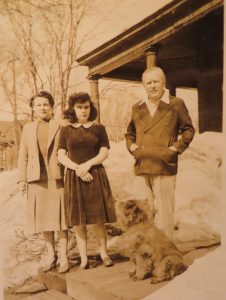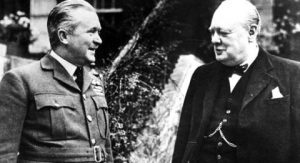Billy Bishop was Canada’s top flying ace of the First World War, and was officially credited with 72 victories. He was the first Canadian airman to receive the Victoria Cross, as well as several other decorations. The Toronto Islands airport is named after him.

During the Second World War, Bishop played an important role as Director of Recruiting for the Royal Canadian Air Force, promoting the British Commonwealth Air Training Plan, selling war bonds and conducting inspection tours. He particularly enjoyed addressing graduating classes of airmen and giving them their wings. He kept a hectic schedule of travelling and public speaking that gradually took a toll on his health. He left government service at the end of 1944 to return to the private sector and died in 1956 at the age of 62.
Bishop lived at 5 Blackburn Ave. between 1940 and 1945. Built in 1905, Fraser House is a large two-and-a-half storey red brick building located among other stately homes and a significant example of the Edwardian Classical style. At different times, this mansion also housed the Italian embassy, the Victorian Order of Nurses and the Heritage Canada Foundation. The elegant carriage house at the back was one of the earliest purpose-built car garages in Ottawa.
Billy Bishop rented this house during the war (although he was well-off, Bishop never bought a house) and lived there with his wife Margaret (grand-daughter of Timothy Eaton), two children (Arthur and Margaret Marise) as well as a cook and a chauffeur (Percy Lethbridge, “Leffo” had become part of the family after having lived many years with the Bishops in London and Montreal). Both of Bishop’s children joined the air force, his son as a Spitfire pilot and his daughter as a wireless radio operator. Bishop believed in inculcating the value of money to his children and gave them an allowance out of which they had to buy their own clothes, books, transportation and other necessities. He taught his son to fly but would not let him use the family car.
His son writes that “in his mid-forties” Bishop “was a massive man, with bulging biceps, a barrel of a chest and a growing girth”. (Bishop, 1965) He liked to dress well and had his suits made to measure. He was an energetic, gregarious bon vivant and an eloquent public speaker.
Eaton), two children (Arthur and Margaret Marise) as well as a cook and a chauffeur (Percy Lethbridge, “Leffo” had become part of the family after having lived many years with the Bishops in London and Montreal). Both of Bishop’s children joined the air force, his son as a Spitfire pilot and his daughter as a wireless radio operator. Bishop believed in inculcating the value of money to his children and gave them an allowance out of which they had to buy their own clothes, books, transportation and other necessities. He taught his son to fly but would not let him use the family car.
His son writes that “in his mid-forties” Bishop “was a massive man, with bulging biceps, a barrel of a chest and a growing girth”. (Bishop, 1965) He liked to dress well and had his suits made to measure. He was an energetic, gregarious bon vivant and an eloquent public speaker.
Bishop had a sharp sense of humour (his son says he had a unmatched repertoire of ribald jokes). In 1928, at a special luncheon in his honour at the Berlin Aero Club, Bishop responded to a toast by Herman Goering (a German war ace himself) by saying: “You honour me for having shot down more German planes than any other Allied airmen. But I now ask you to honour me as Germany’s greatest ace.” To his puzzled hosts, he then added “I personally destroyed more Allied planes by my own method of landing than all of you combined!” (Bishop, 1961)
In December 1941, Bishop brought Winston Churchill to his house for drinks (at Churchill’s suggestion) after both had had dinner with Prime Minister King at Laurier House. Bishop and Churchill had been close friends since the 1920s: they had played polo together and Bishop had campaigned for Churchill in the 1925 election when he lived in London. Bishop lived just a block away from King and was known to keep a fine liquor cabinet. King, on the other hand, always abstemious, had given up alcohol during the war.
During the visit, Churchill remarked upon a porcelain figurine of a sow feeding its piglets that Bishop kept on a shelf. “That old sow is me,” said Churchill. “My ministers constantly ask me for more resources and I have to remind them that there are not enough teats for everyone!” Ever since, the Bishops nicknamed that porcelain sow Winnie.
Other dignitaries the Bishops entertained in Sandy Hill included Fiorello La Guardia (Mayor of New York), President Benes of Czechoslovakia, Princess Juliana and Prince Bernhardt of the Netherlands and of course Prime Minister King.

In 1942, Bishop, playing himself, appeared in a cameo role in a Hollywood movie featuring James Cagney (Captains of the Clouds) that celebrated the exploits of the RCAF.
